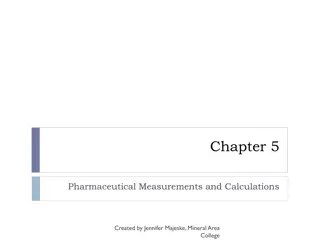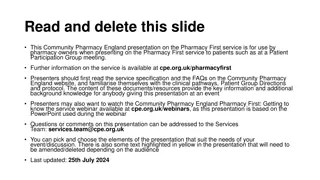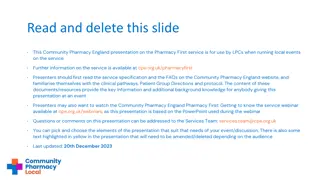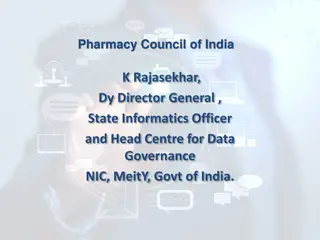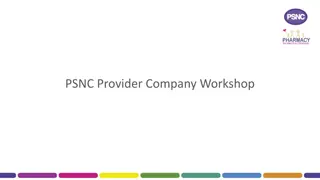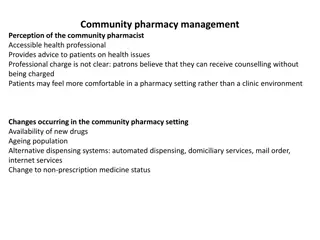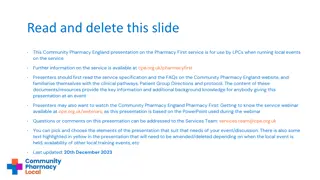Comprehensive Guide to Community Pharmacy Management
Background perception of community pharmacists as accessible health professionals, changes in the community pharmacy setting, challenges faced, business operations, personnel management, and starting a pharmacy business are discussed in detail. Key points include patient comfort, new drug availability, financial viability, and personnel training and development.
Download Presentation

Please find below an Image/Link to download the presentation.
The content on the website is provided AS IS for your information and personal use only. It may not be sold, licensed, or shared on other websites without obtaining consent from the author. Download presentation by click this link. If you encounter any issues during the download, it is possible that the publisher has removed the file from their server.
E N D
Presentation Transcript
Community Pharmacy Management Dr. Haider Raheem
Background Perception of the community pharmacist Accessible health professional Provides advice to patients on health issues Professional charge is not clear: patrons believe that they can receive counselling without being charged Patients may feel more comfortable in a pharmacy setting rather than a clinic environment
Changes occurring in the community pharmacy setting Availability of new drugs Ageing population Alternative dispensing systems: automated dispensing, domiciliary services, mail order, internet services Change to non-prescription medicine status.
Challenges in the community pharmacy setting Financial viability Preservation of market share as opposed to competition from supermarkets, internet pharmacy and other sources to get drugs Cost containment Keeping up with ethical and legal considerations; the misconception that having a good business aspect is inconsistent with good clinical practice is very often discussed Use of computer technology to connect with prescribers and maintain patient s profile Time management to allow for new patient contact interventions required.
Business operations Accounting: keeping records Finance: monitoring cash Personnel management: managing people, training and development Production: time-and-motion studies Administration: payments, legal requirements, ordering.
Personnel management Appointing and dismissing of staff: issuing contracts and drawing up job descriptions Health, safety and welfare Training and development. Good professional pharmacy services and meets expectations regarding the quantity and quality of the care received. management improves the satisfaction of patients with
Starting a pharmacy Plan the business Strategic planning and identifying legal form of business (proprietor, partnership, company) Capital needs: obtain financing Location and licenses Set up records Insure the business Manage the business.
Plan the business For businesses where the pharmacy already exists and is being taken over, this step is essential to evaluate costs incurred in acquiring a business. Review history: for already existing businesses, the sales and profit; for a new pharmacy look at potential for clients Assess condition of facilities and identify and cost any upgrades necessary Estimate maximum realistic profit that can be generated For already existing businesses, assess ability to transfer goodwill to new owner.
Strategic planning Identify targets according to timeframes where the business should be Assess the impact of changes on targets Develop and implement procedures and policies.
Capital needs Establish how to finance starting up business: enquire with banks regarding loans and repayments and work out how these conform with the expected profits Set-up capital: buying or renting business and/or premises insurance fixtures equipment Stock Start-up capital: capital needed to get it started immediately prior to opening or during the first few weeks decorative fixtures office supplies Operating capital: expansion cash shortages.
Location Population: community demographic data Competition with other businesses Availability of physicians and primary care clinics, collaboration with prescribers in the area Retail shops close by may serve as a positive point in that the area is considered as a shopping centre Traffic direction may hinder access to the pharmacy or may have a positive influence on patron s choice, availability of parking space. The accounting system for a pharmacy should be developed in a way that it is easily understandable and serves the needs of the pharmacy. Financial records are required both for internal and for external reasons.
Product lines Decision on what to stock: not to delay dispensing a prescription not recommended to keep a product just in case someone needs something because overstocking may lead to money tied in stock or to stock that will become shop soiled or past its expiry date Carry out study sales Identify prescribers in the area and define drugs that they prescribe.
Buying merchandise Right quality Right quantity Right supplier Right time.
Policies and procedures Specific policies and procedures are needed for specific tasks to explain the procedure and who is authorised to: place orders and receive merchandise update legal records keep financial records check stock, update and maintain formulary.
Sources of supply Reliability Order-processing time Delivery Risk Credit extension.
Merchandise control Expiry date Shop-soiled items Slow moving merchandise Stock levels.
Services offered Methods of payment for clients: acceptance of credit cards Provision of domiciliary services and delivery to institutions and house-bound patients Dispensing services: emergency prescription dispensing, unit-dose dispensing, containers Patient profile cards Point-of-care testing: blood pressure monitoring, blood tests Patient monitoring, medication review and patient counselling Controversial issues: advertising and slashing prices, discounts.
Personal selling skills Identifying prospective customers Approaching clients Attracting attention to the services provided Handling queries Follow-up of interaction with clients.
Design and layout Physical environment Promote atmosphere that is pleasing, conducive to shopping and professional Psychological effect or feeling created by physical characteristics of the pharmacy. Pharmacy layout Planning the internal arrangement of departments and allocating the amount of space for each department Designed to direct traffic around the pharmacy Space allocated to specific departments depending on profitability Maximising exposure of products.
Product presentation Most saleable and profitable items in the most prominent locations Products arranged by pack size, colour, brand, price Eye-level positions rather than bottom or top shelves Prepare impulse purchase items on counter Identify fast moving products.
Shop-window display Pleasing Matches image projected by the pharmacy Simple Clean and neat. A large number of purchases from the pharmacy with regard to non- prescription items and parapharmaceuticals occur as a result of impulse buying. Methods used to attract clients to the pharmacy and to display the stock, and the stock displayed, influence impulse buying.
Financial operating processes Journals Purchases journal: to record credit purchases (supplier, amount, when payment is due) Sales journal: to record accounts receivable Cash disbursements journal: to record purchases paid. Balance sheet A balance sheet is a statement of the financial condition of the business at a given point in time. It reflects what is owned by the pharmacy, what it owes and what the owner has invested.
Financial operating processes Assets Current assets: convertible into cash within a year (e.g. short-term stock) Fixed assets: not used within 1 year (e.g. computer, office equipment) Intangible assets: goodwill. Liabilities Amounts owed to creditors. May be current liabilities (must be paid within 1 year) or long-term liabilities (e.g. bank loans).
Computers in pharmacy Used for stock control, purchases and supplies Used for professional services. Computer use for professional services Electronic patient records Presenting point of access to patient information on the web Management of prescribed medicines Promotion of healthy lifestyles: development of compact discs Pharmacy webpage, on-line pharmacy services.
Computer audit Password to limit access to authorised personnel Back-up copies Keep up regular physical counts of stock and expiry dates. In converting from a manual system to a computerised system or from one computer system to another it is advisable to keep a parallel version (the old system) for some time. This reduces the risk of errors. However, it is more expensive.
Advantages of computerisation Improved business information Increased work quality Better organisation of business Record keeping: patient profiles Stock status immediately available and controlled.
Disadvantages of computerisation Initially demanding on staff Conversion from manual to computerised system may be traumatic Generates a large amount of information which may be of little value to business but distracts attention from major issue Investment required: computer hardware and peripherals (e.g. printers), software, back-up and storage.
Steps in acquiring a computer Identify the activities that will be carried out with the computer system Select adequate hardware (including right memory) and software Select the vendor that provides the system according to specifications required and has after-sales services Install system and train the users.








